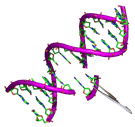Gene Therapy
The Future of Genomic Medicine

Genetic Engineering Diagram
Gene editing can be an excellent treatment method for many seemingly untreatable diseases. The techniques have been around since the 90s but have greatly improved in their methods and the popularity of the procedures in recent years. Though the process is often seen as controversial, we are in agreement that, when necessary, gene editing is a positive form of patient treatment.
Despite the fact that many support this method, plenty of people disagree. The high costs, hundreds of thousands to millions, make the treatment unreachable to most considering it. The ethics of gene editing is also often questioned. Should scientists alter what nature predisposes humans to? With this, we fear discrimination. The science world may label genetic diseases ‘“bad,” making those affected feel less than others. “But we should be reminded that bad genes don’t necessarily lead to bad lives, just as good genes don’t necessarily lead to good lives” (Scientific American). The journal justifies living with illness and how each situation is different. The procedures also have unknown risks that we have yet to see in the long term or in rare cases. All of this combined makes a valid argument to question gene editing.
Regardless of its critics, genomic editing can be a perfect treatment for many. The easy-to-see positives are successive research on HIV/AIDS, prenatal cases, CF, cancers, and other rare illnesses. In extreme cases, gene editing can give relief to many patients or even avoid illness in unborn children. CRISPR, the first program, had successful research in a prenatal case.
Twins in China had their CCR5 gene edited to avoid HIV being passed to them. A biology teacher at Pennridge High School, Christi Kuntz, spoke on how genetic editing could have been possible in her life. If both she and her husband were positive for the mutated CFTR gene, they could have passed Cystic Fibrosis to their children. In that case, she felt much more informed, stating, “If in the situation, yes, I would use the procedure to make sure my kids were healthy.” Mother of two, Wendy Cipressi agreed with Christi, saying, “I would opt to edit the genetics to avoid bringing an ill child into the world knowing they’d suffer.” Currently, research is also being done in testing and preventative genomic treatments, hopefully soon bearing positive results.
With all the positives and successive research done, it’s apparent that gene editing has many medical benefits. When it comes down to it, for most, it is decided that the procedures have positive results, making the treatment a good option for those in need.
Sources:
https://www.fda.gov/vaccines-blood-biologics/cellular-gene-therapy-products/what-gene-therapy
https://www.ncbi.nlm.nih.gov/pmc/articles/PMC2907101/#:~:text=On%20September%2014%2C%201990%2C%20W
https://www.scientificamerican.com/article/the-dark-side-of-crispr/
https://commons.wikimedia.org/w/index.php?curid=75624775
[1] Note: Testing showed she could not give her children CF, but the question was asked in the essence of if the situation was a positive result.
Sara Cipressi, Grade 12. Sara’s in-school involvement includes the student council (president), NHS, NOVA, and the dance team. Outside of school, she...



